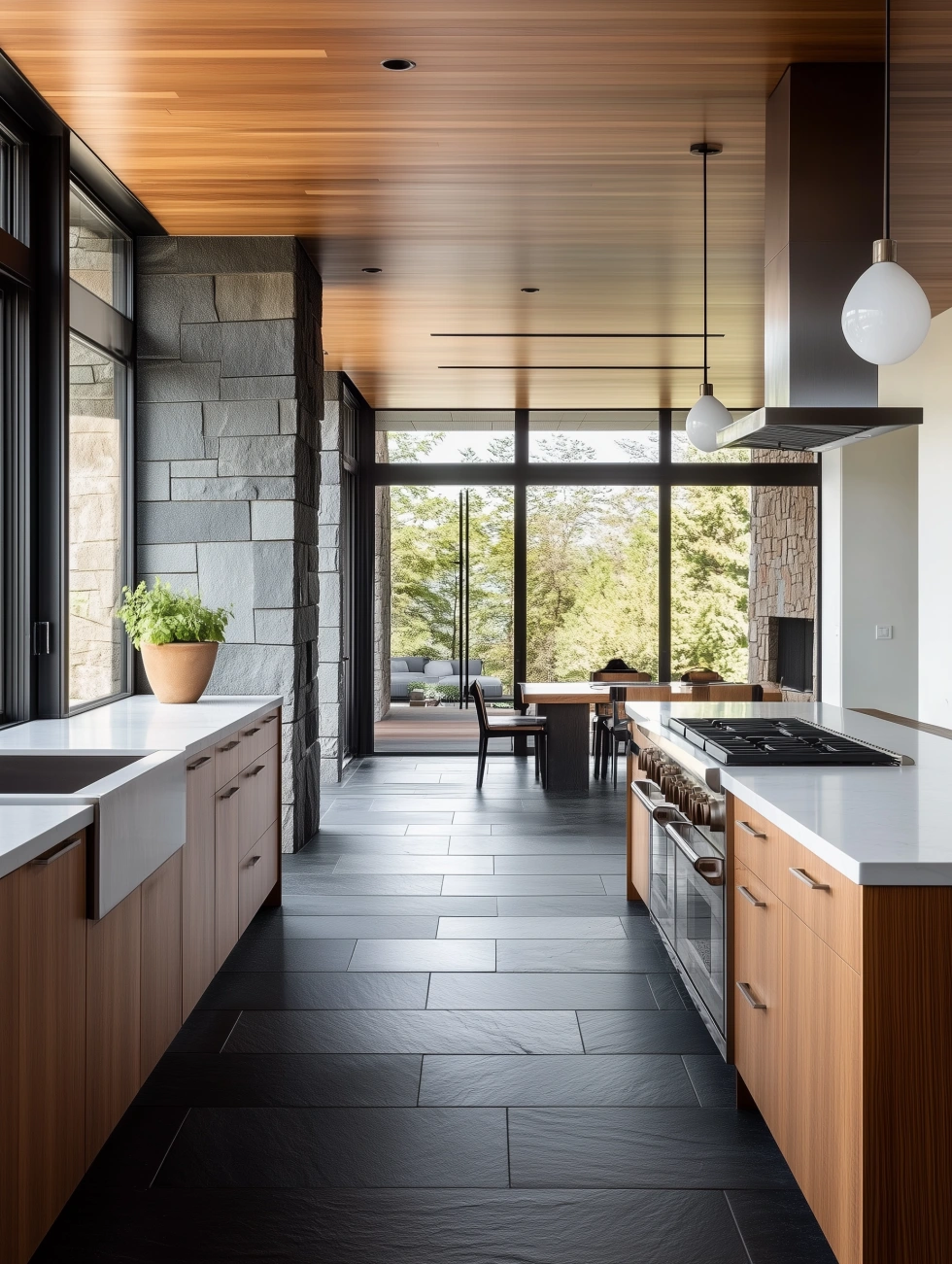
Kitchen floor tiles can transform the heart of your home, adding style and functionality to your cooking space.
The floor is an essential component of any kitchen design and critical to get right when planning your kitchen renovation -or even if you are simply looking to refresh your kitchen’s look.
Whereas, as I know to my cost, engineered wood flooring can wear quite quickly, any kitchen floor tile solution (if properly fitted) offers versatility and durability that’s hard to beat.
This is critical to the kitchen because of the likelihood of spills etc. and because the kitchen is probably the most high-trafficked area of the home.
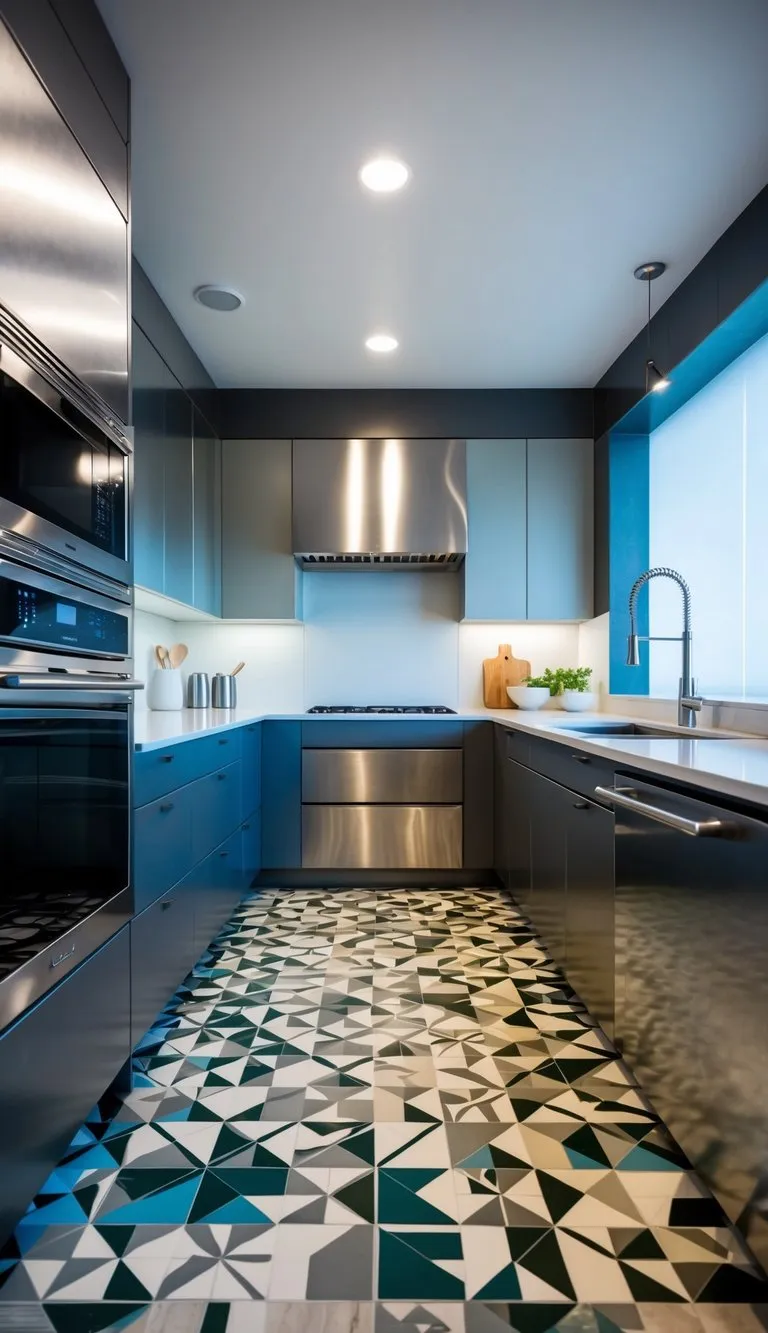
Choosing the right kitchen floor tiles can lift your space from ordinary to extraordinary, creating a foundation that ties your entire design together.
There are so many options – from bold patterns to subtle textures – that there’s a tile option to suit every taste and budget.
Let’s explore twelve modern kitchen floor tile ideas that will inspire your next project and help you create a stunning, on-trend kitchen.
1) Ceramic Hexagon Tiles
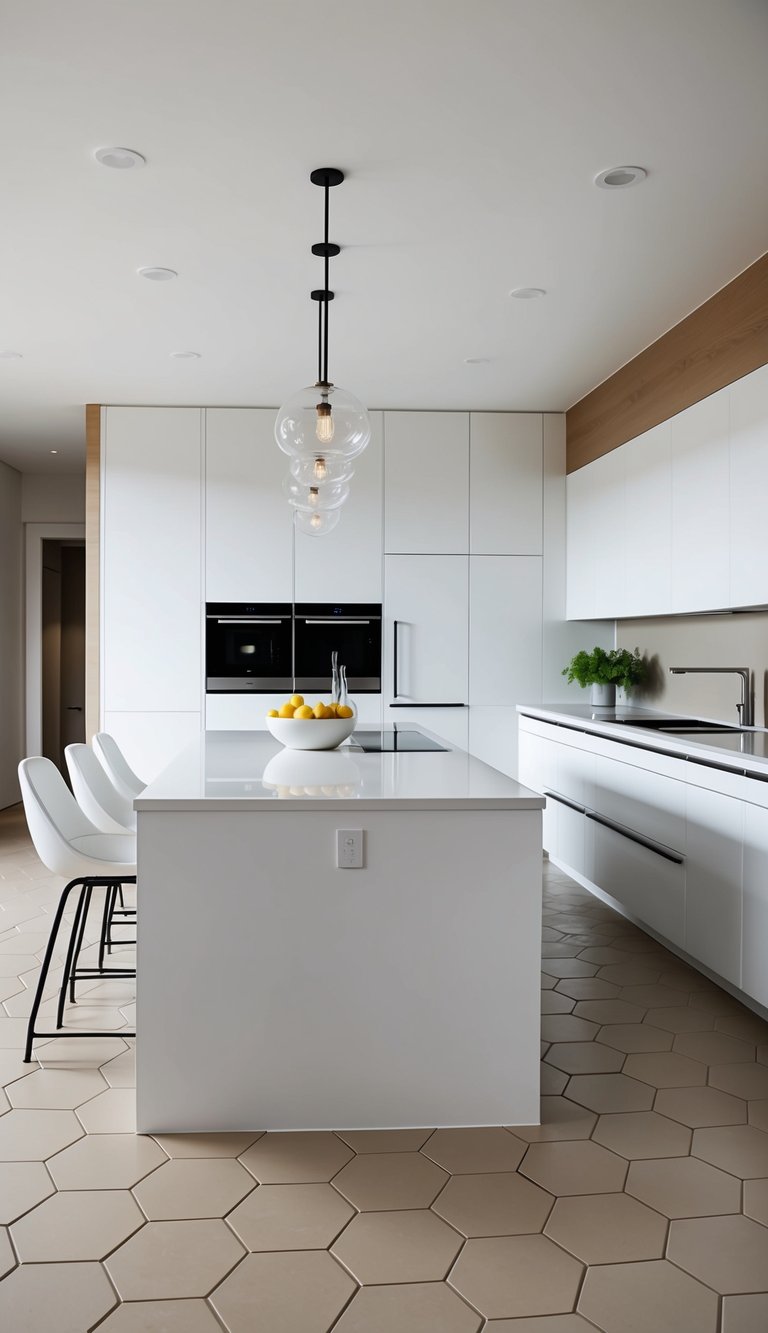
Ceramic hexagon tiles offer a stylish and modern option for your kitchen floor. These six-sided beauties can transform your space with their unique geometric shape and versatile designs.
You’ll find ceramic hexagon tiles in a wide range of colours and patterns. From bold, contrasting hues to subtle, monochromatic schemes, there’s a style to suit every taste. Consider using white tiles with black grout for a classic look, or mix different shades for a more eclectic feel.
The size of hexagon tiles can vary greatly. Larger tiles create a sleek, contemporary appearance, while smaller ones add intricate detail and texture to your kitchen floor. You might even combine different sizes for a truly eye-catching design.
Ceramic hexagon tiles are durable and easy to clean, making them ideal for busy kitchens. They resist stains and moisture, ensuring your floor stays looking fresh for years to come.
For added visual interest, try laying your hexagon tiles in unique patterns. You could create a honeycomb effect or experiment with ombre transitions between colours. The possibilities are endless, allowing you to customise your kitchen floor to your exact preferences.
2) Porcelain Wood Look Tiles
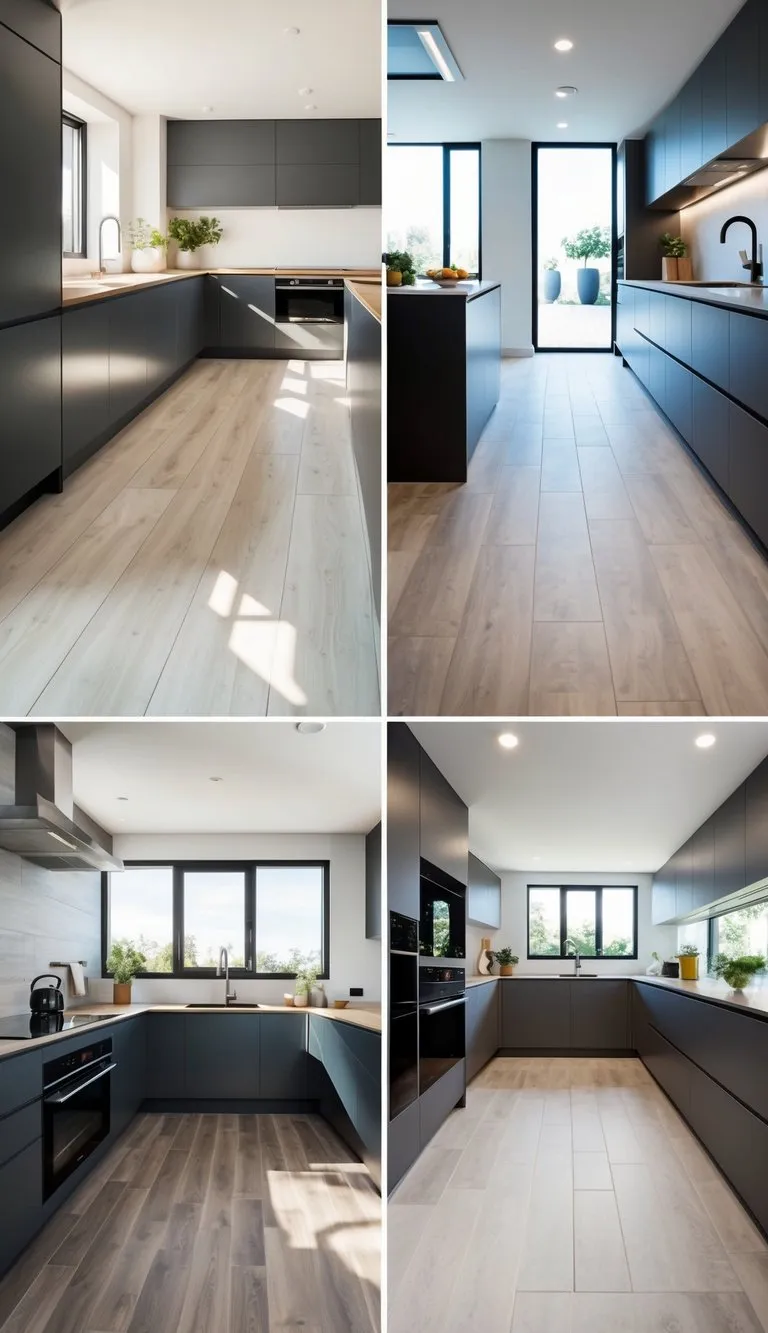
Porcelain wood look tiles offer a brilliant solution for modern kitchens, combining the warmth of wood with the practicality of ceramic. These tiles mimic the appearance of hardwood flooring whilst providing superior durability (see my comment in the intro) and water resistance.
You’ll find a wide range of styles available, from rustic oak to sleek walnut, allowing you to match your kitchen’s aesthetic perfectly. The tiles come in various plank sizes and can be laid in patterns like herringbone for added visual interest.
One of the main advantages of porcelain wood tiles is their ease of maintenance. Unlike real wood, they won’t scratch, dent, or stain easily, making them ideal for busy kitchen environments. They’re also resistant to moisture, a crucial feature in areas prone to spills.
Installation is straightforward, and these tiles can be used with underfloor heating systems for added comfort. You can create a seamless look throughout your open-plan living space by using the same tiles in adjacent areas.
Porcelain wood tiles are a cost-effective alternative to real hardwood, offering long-lasting beauty without the high maintenance requirements. They’re an excellent choice for homeowners seeking a modern, stylish kitchen floor that stands up to daily wear and tear.
3) Marble Effect Tiles
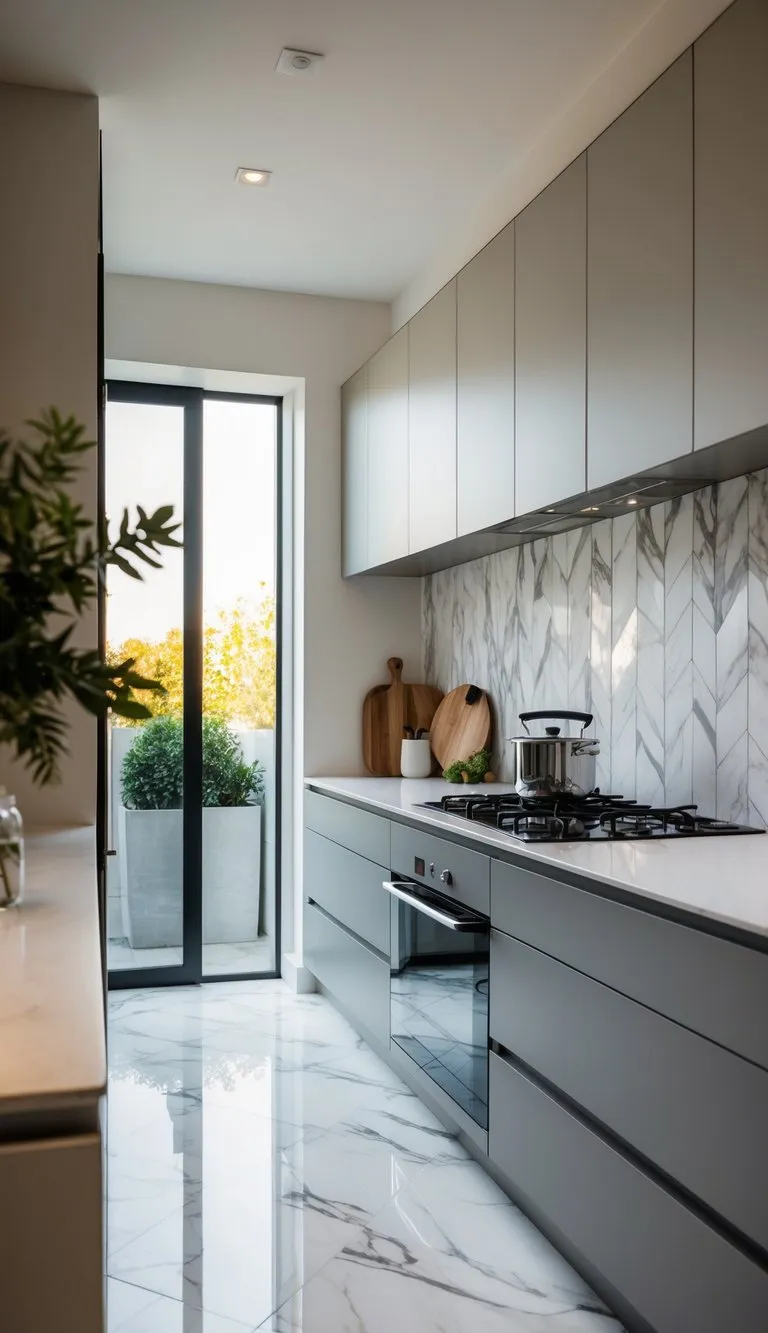
Marble effect tiles offer the luxurious look of natural marble without the high cost and maintenance. These tiles are perfect for creating a sleek, modern kitchen floor with timeless appeal.
You’ll find marble effect tiles in a range of colours and patterns, from classic white with grey veining to bolder options like black or green. The variety allows you to match your kitchen’s colour scheme whilst adding visual interest.
These tiles are typically made from porcelain or ceramic, making them more durable and easier to clean than real marble. They’re resistant to stains and scratches, ideal for busy kitchens.
For a contemporary look, opt for large-format tiles with minimal grout lines. This creates a seamless appearance that can make your kitchen feel more spacious.
Consider pairing marble effect floor tiles with contrasting cabinets or worktops. White marble-look tiles complement dark cabinetry beautifully, whilst grey veined options work well with lighter kitchen elements.
Don’t forget about texture. Some marble effect tiles come with a matte finish for a more subtle look, whilst others have a polished surface that mimics the sheen of natural marble.
4) Slate Grey Stone Tiles
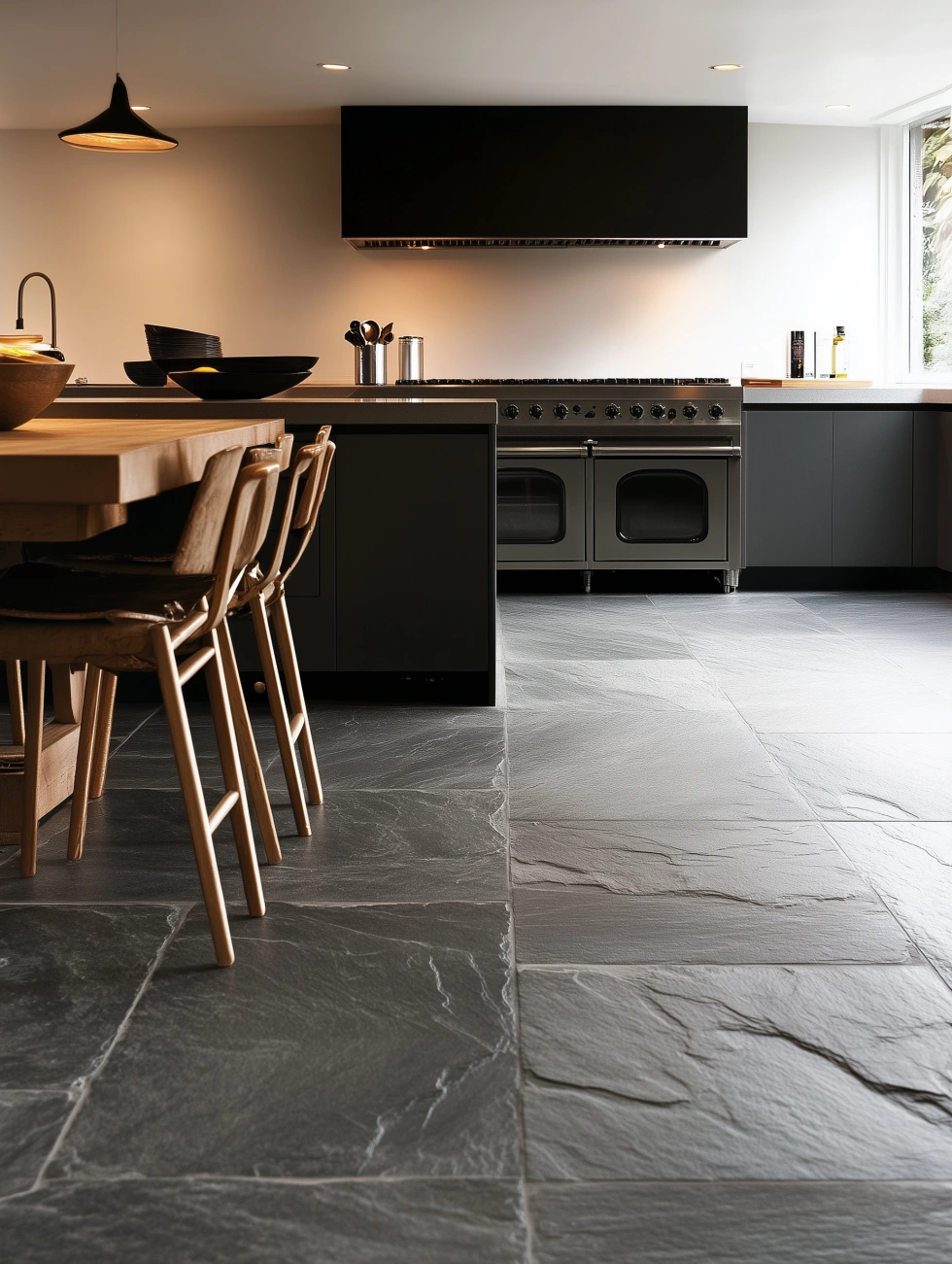
Slate grey stone tiles offer a sophisticated and timeless look for your modern kitchen floor. Their natural, earthy appearance brings warmth and character to the space whilst maintaining a sleek aesthetic.
These tiles come in various shades of grey, from light to dark, allowing you to choose the perfect tone to complement your kitchen’s colour scheme. The subtle variations in each tile create visual interest and depth.
Slate tiles are known for their durability and resistance to wear, making them an excellent choice for high-traffic areas like kitchens. They’re also easy to clean and maintain, requiring only regular sweeping and occasional mopping.
For added texture and visual appeal, consider opting for tiles with a slightly rough or cleft surface. This can provide better grip underfoot, especially when the floor is wet.
To enhance the modern feel, you might pair slate grey tiles with contrasting elements such as light-coloured cabinetry or stainless steel appliances. This combination creates a striking balance in your kitchen design.
When selecting slate tiles, ensure they’re properly sealed to protect against stains and moisture. This will help preserve their beauty and extend their lifespan in your kitchen.
5) Patterned Encaustic Tiles
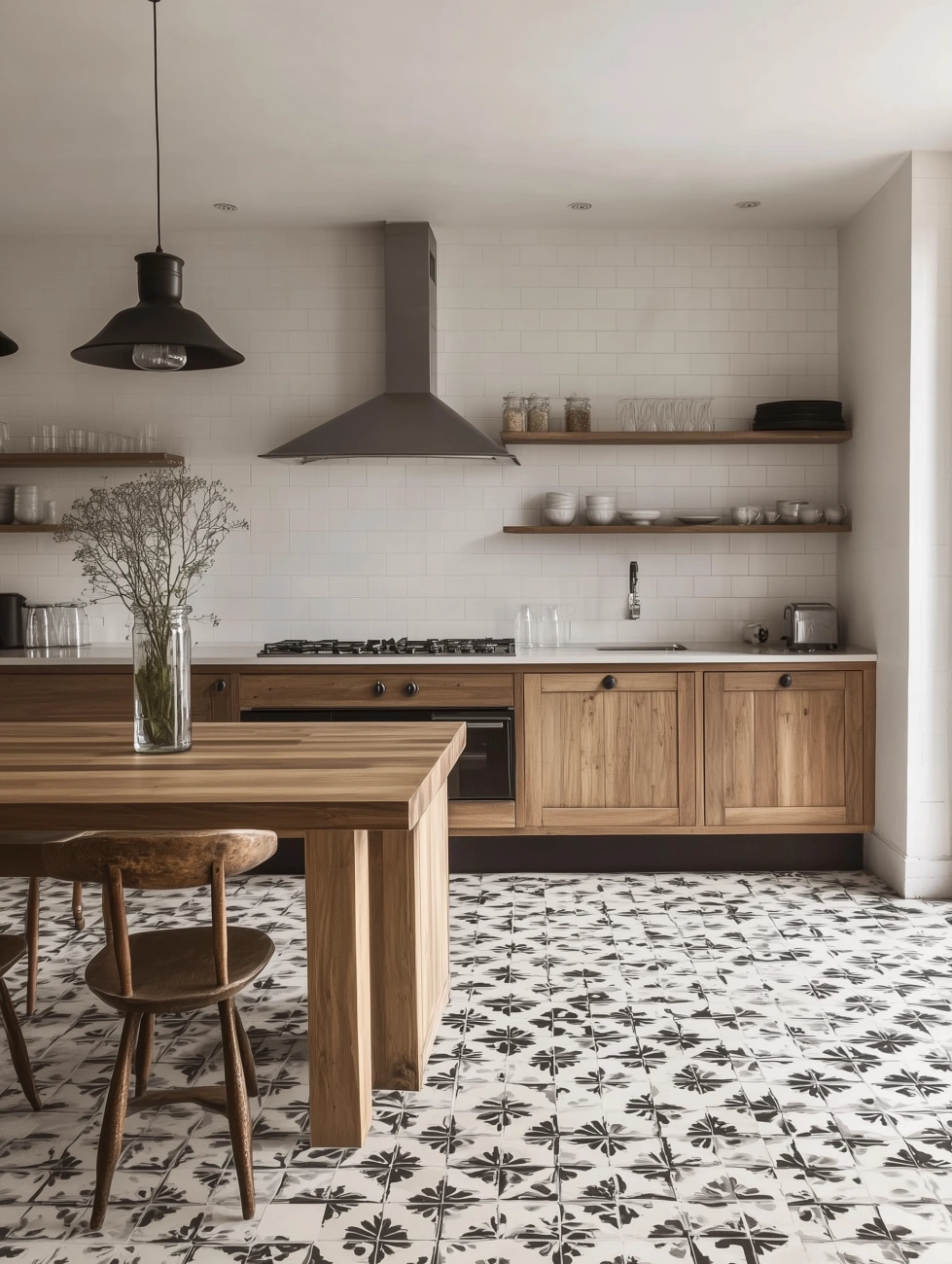
Patterned encaustic tiles can transform your kitchen floor into a stunning focal point. These vibrant tiles, with their Moorish-inspired designs, add a touch of exotic elegance to modern kitchens.
You’ll find encaustic tiles available in a wide array of colours and patterns. From bold geometric shapes to intricate floral motifs, there’s a design to suit every taste. Consider using larger-scale patterns in smaller kitchens to create a more cohesive look.
These tiles work brilliantly with both contemporary and traditional interiors. Pair them with sleek, minimalist cabinetry for a striking contrast, or complement them with rustic wooden elements for a warm, eclectic feel.
Encaustic tiles are surprisingly versatile. You can use them to define specific areas in open-plan kitchens or to create a decorative ‘rug’ effect under a dining table. For a more subtle approach, try using patterned tiles as a border around plain flooring.
Modern versions of encaustic tiles are durable and easy to maintain, making them a practical choice for busy kitchens. They’re also an excellent option if you’re looking to add character and personality to your space without overwhelming it.
6) Large Flagstone Tiles
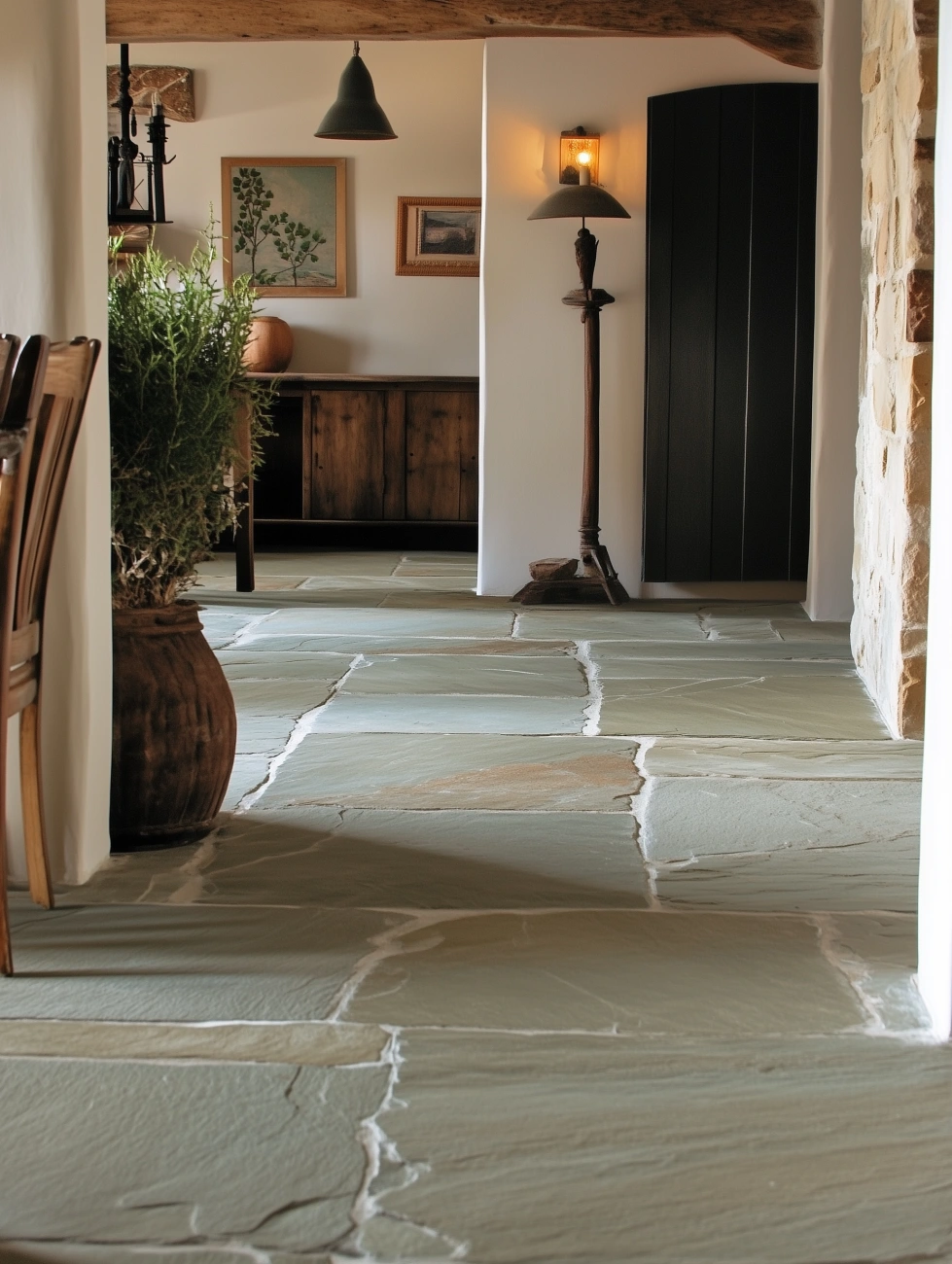
Large flagstone tiles can make a striking statement in your modern kitchen. These expansive, natural stone tiles bring a touch of rustic charm while maintaining a sleek, contemporary aesthetic.
You’ll find flagstones in various colours, from warm earthy tones to cool greys. Their irregular shapes and textured surfaces add visual interest to your kitchen floor.
For a truly modern look, opt for flagstones with clean-cut edges and a honed finish. This creates a smooth, matte appearance that complements minimalist kitchen designs.
Consider using large-format flagstones to create an illusion of more space in smaller kitchens. The fewer grout lines can make your floor appear seamless and expansive.
Pair your flagstone tiles with underfloor heating for added comfort during colder months. The natural stone retains heat well, making your kitchen feel cosy and inviting.
To maintain the modern aesthetic, choose a grout colour that closely matches your tiles. This will create a unified look and allow the beauty of the flagstones to take centre stage in your kitchen.
7) Large Format Concrete Tiles
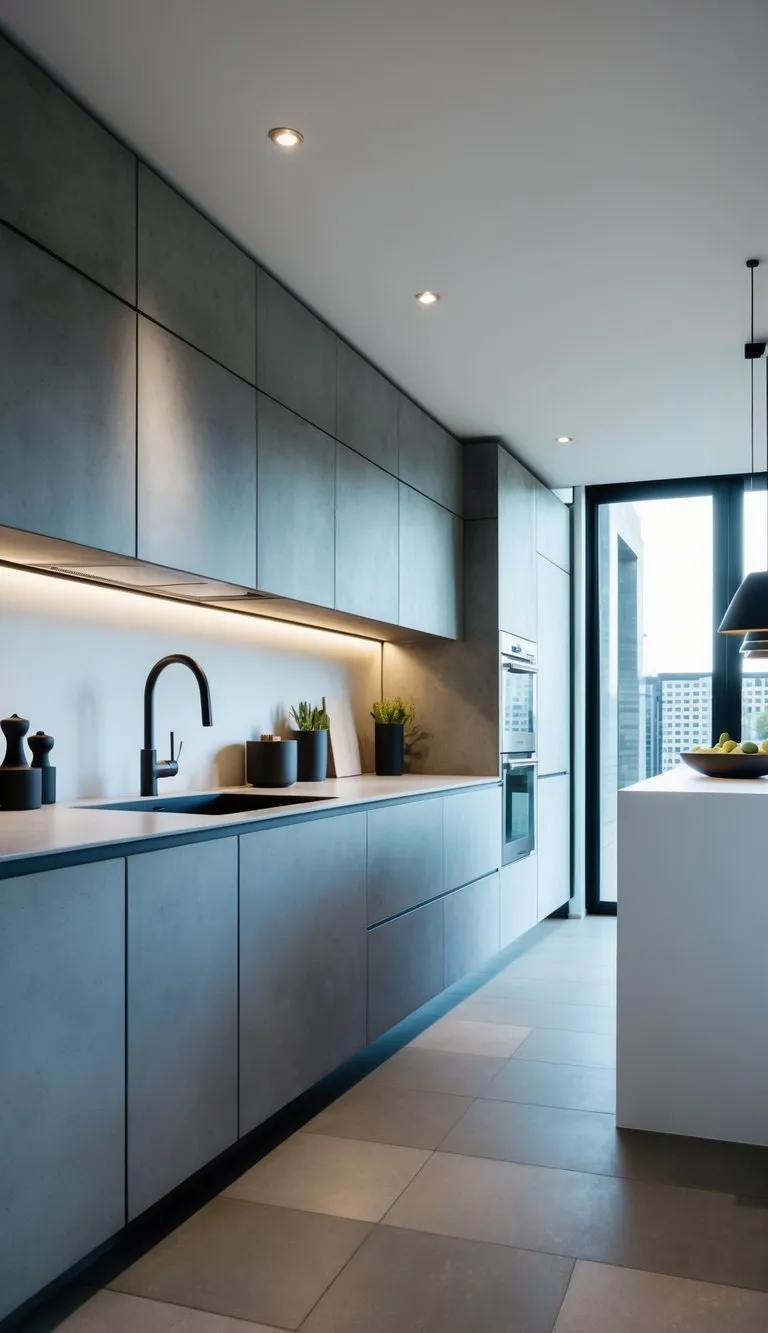
Large format concrete tiles offer a sleek and modern look for your kitchen floor. These expansive tiles create a seamless appearance with fewer grout lines, making your space feel more open and cohesive.
You can choose from a range of grey shades to suit your kitchen’s colour scheme. Lighter greys can brighten up the room, while darker tones add depth and sophistication.
The concrete-effect finish provides a contemporary industrial vibe that pairs well with various kitchen styles. It’s particularly striking in minimalist or urban-inspired designs.
These tiles are not only visually appealing but also practical. They’re durable, easy to clean, and resistant to stains and scratches—ideal for busy kitchens.
You can enhance the look by incorporating underfloor heating, which works efficiently with large format tiles. This adds a touch of luxury and comfort to your kitchen space.
Consider pairing these tiles with warm wood elements or colourful accents to create an interesting contrast. This balance prevents the concrete look from feeling too cold or austere.
8) Limestone Tiles
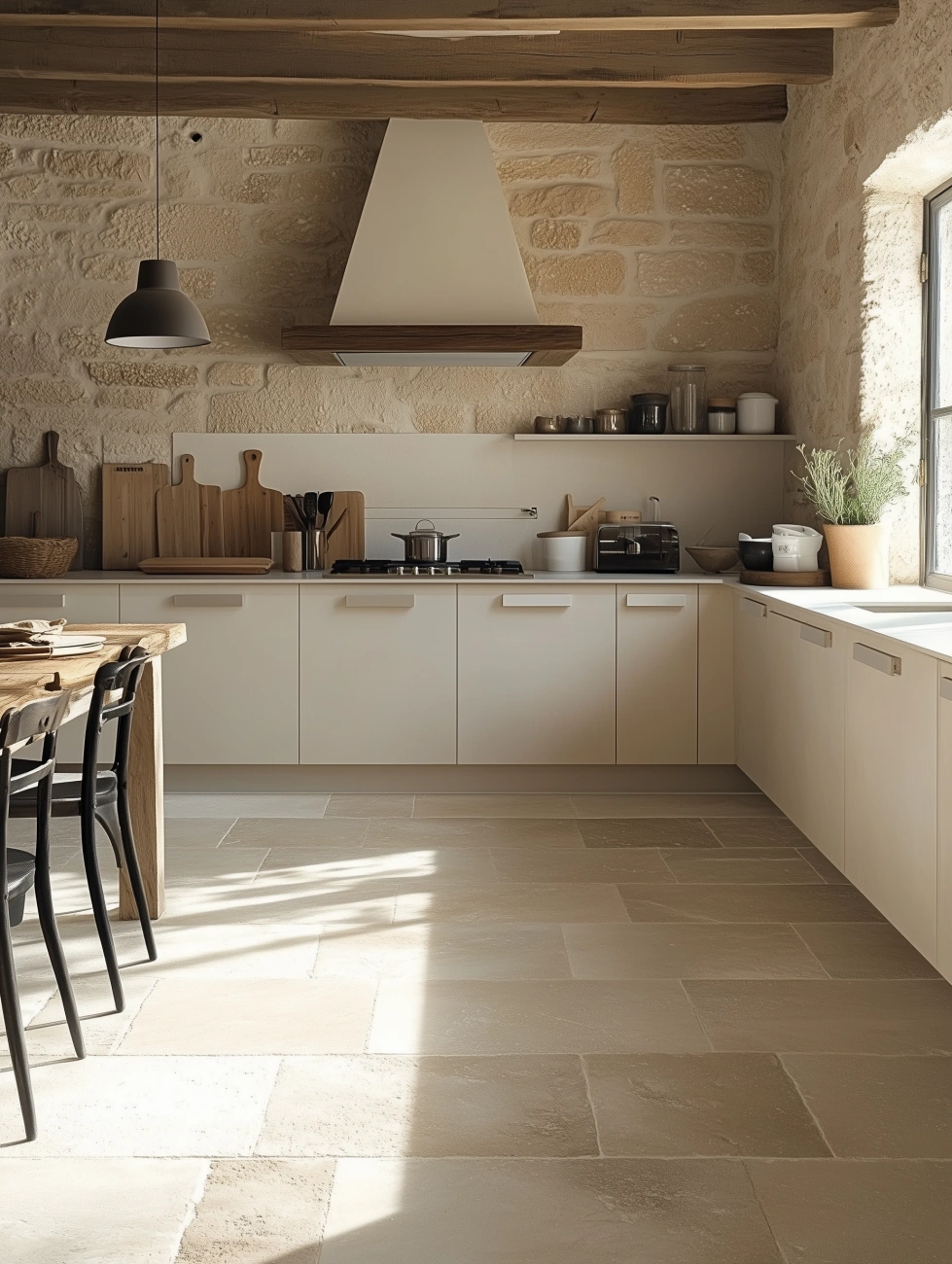
Limestone tiles offer a timeless elegance to modern kitchens. Their natural, earthy tones range from soft beiges to warm greys, creating a soothing atmosphere in your culinary space.
These tiles are incredibly versatile, complementing various kitchen styles. You can opt for a polished finish for a sleek, contemporary look or choose a honed surface for a more understated appeal.
Limestone’s durability makes it an excellent choice for high-traffic areas. With proper sealing, these tiles can withstand the daily wear and tear of a busy kitchen whilst maintaining their beauty.
Consider large-format limestone tiles to create a seamless, expansive feel in your kitchen. Alternatively, smaller tiles in herringbone or basketweave patterns can add visual interest to your floor.
Pairing limestone floors with wooden cabinetry or stainless steel appliances can create a striking contrast, enhancing the modern aesthetic of your kitchen. The natural variations in each tile lend a unique character to your space.
Remember to factor in regular maintenance to keep your limestone floors looking their best. With proper care, these tiles will continue to impress for years to come.
9) Terracotta Herringbone Tiles
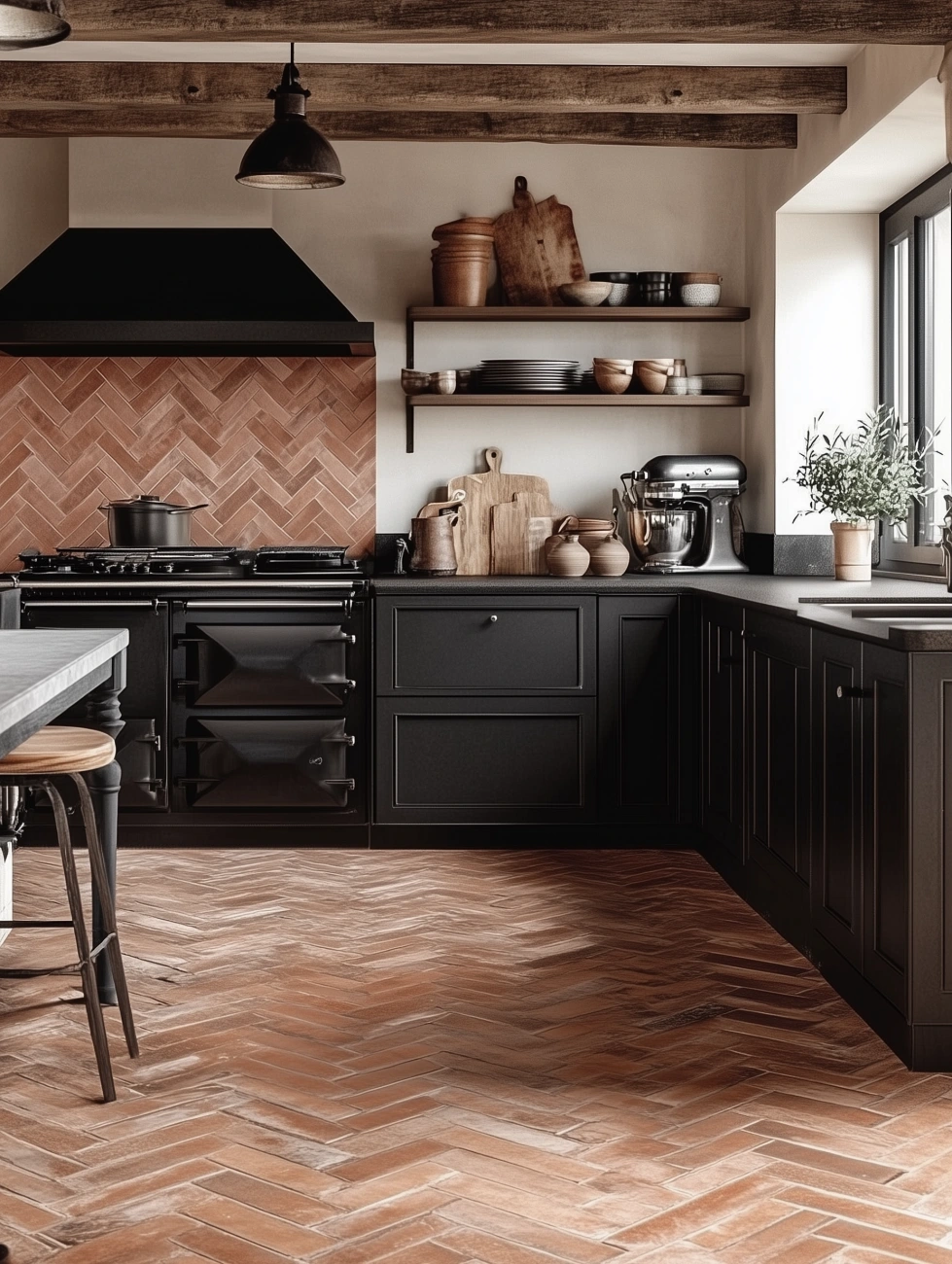
Terracotta herringbone tiles offer a warm, rustic charm to your modern kitchen floor. These earthy-toned tiles bring a touch of Mediterranean flair whilst maintaining a timeless appeal.
The herringbone pattern creates visual interest and movement, making your kitchen appear more spacious. This arrangement is particularly effective in narrow areas between islands and counters or in kitchen hallways.
You’ll find that terracotta’s natural variations in colour and texture add depth to your floor. The rich, reddish-brown hues complement a wide range of kitchen styles, from traditional to contemporary.
For a striking contrast, consider pairing terracotta herringbone tiles with light-coloured cabinetry. This combination can create a visually stunning and balanced look in your kitchen.
Terracotta tiles are known for their durability, making them an excellent choice for high-traffic kitchen areas. They’re also easy to clean and maintain, ensuring your floor remains beautiful for years to come.
To enhance the rustic feel, opt for handmade terracotta tiles. These often have slight imperfections that add character and authenticity to your kitchen floor.
10) Chevron Pattern Tiles
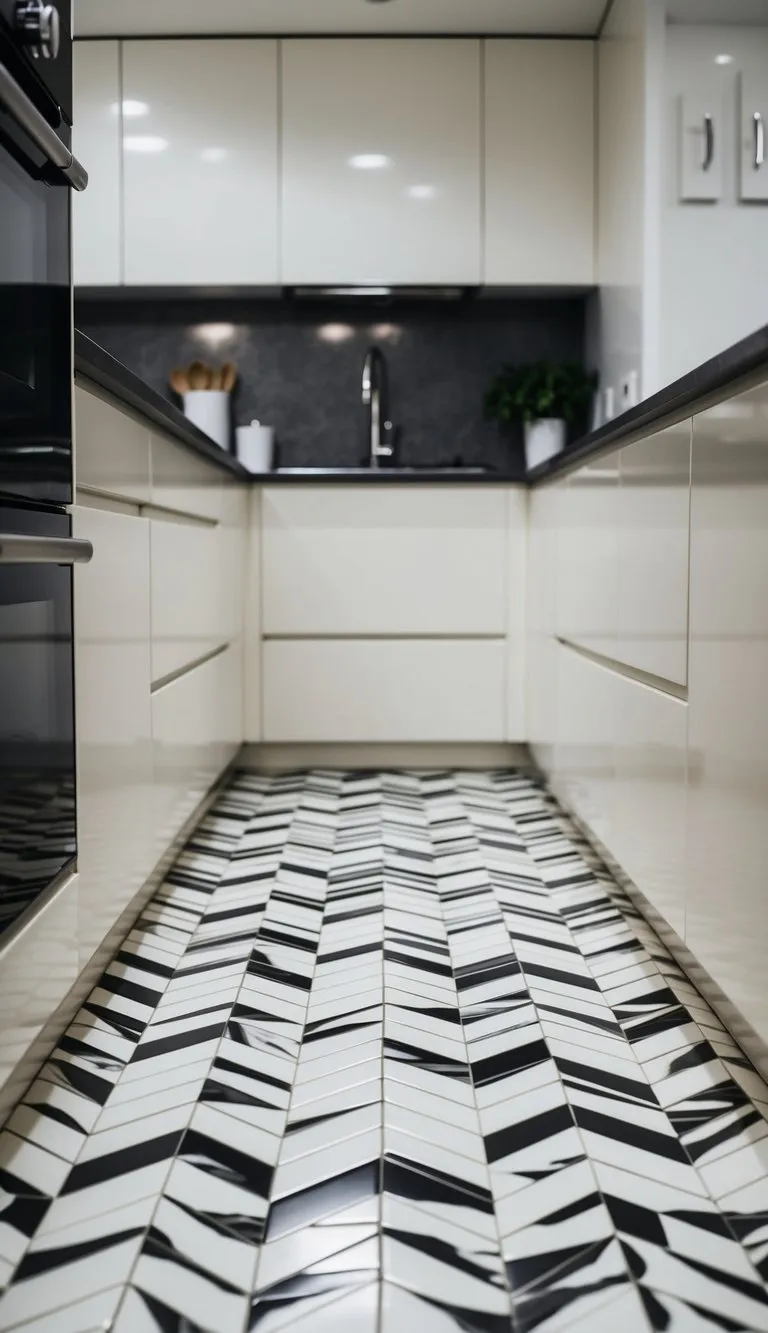
Chevron pattern tiles offer a striking and sophisticated look for your modern kitchen floor. These distinctive tiles create a continuous zigzag pattern, adding visual interest and a sense of movement to your space.
Unlike herringbone, chevron tiles are cut at a 45-degree angle to form sharp, perfect points. This creates crisp V-shapes that draw the eye and make your kitchen floor a true focal point.
You can find chevron tiles in various materials, including porcelain, marble, and even wood-look options. This versatility allows you to choose a style that complements your kitchen’s overall design.
For a bold statement, consider contrasting colours in your chevron pattern. Alternatively, opt for subtle tonal variations to create a more understated yet elegant effect.
Chevron tiles work particularly well in larger kitchens, as the pattern can help to visually elongate the space. However, they can also be effective in smaller areas, such as a kitchen backsplash.
When selecting chevron tiles, consider the scale of the pattern in relation to your kitchen size. Larger chevrons can make a dramatic impact, while smaller ones offer a more delicate touch.
11) Matte Black Slate Tiles
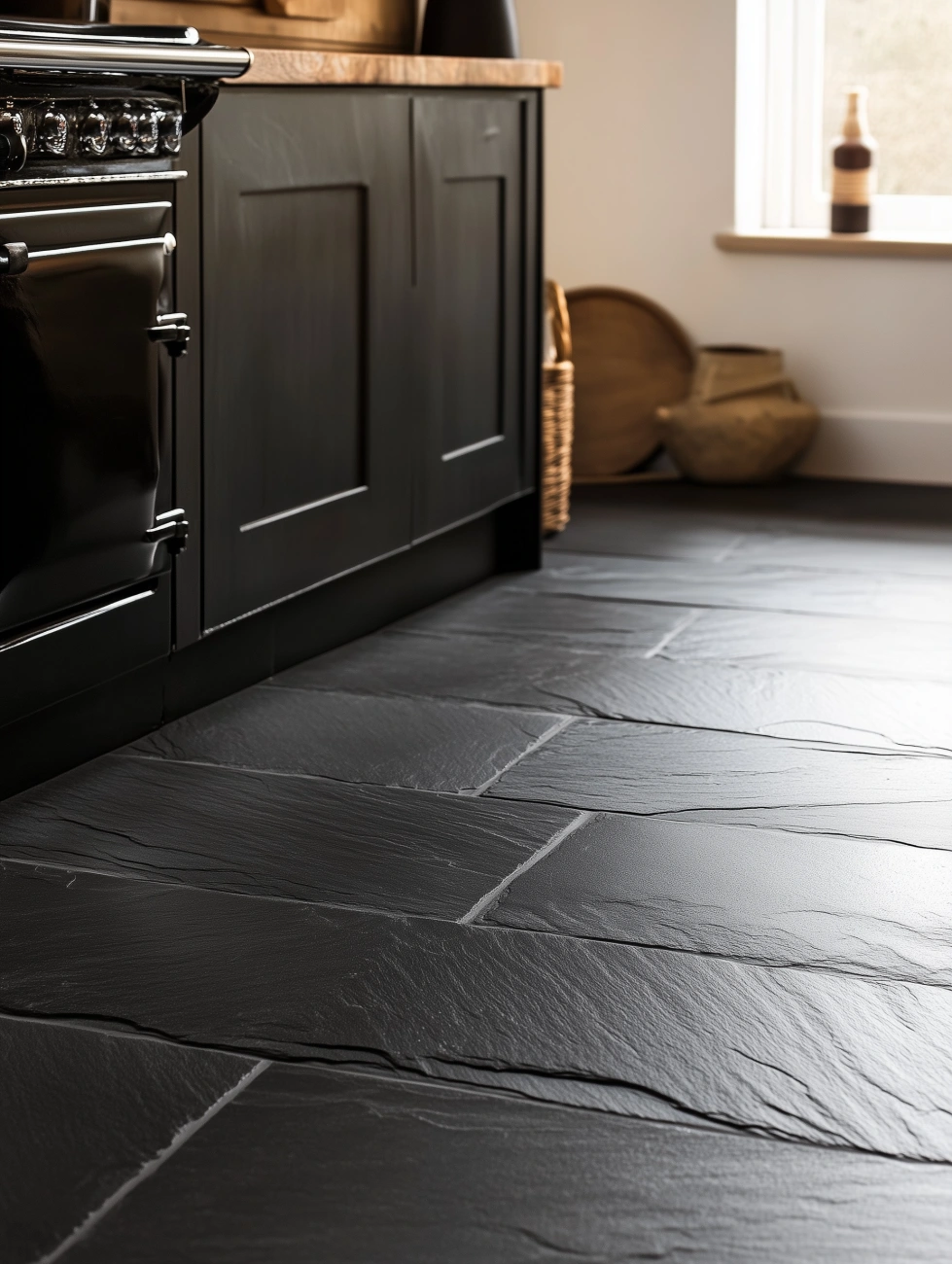
Matte black slate tiles offer a sophisticated and modern look for your kitchen floor. These tiles bring a touch of elegance and depth to the space, creating a striking contrast with lighter cabinetry and worktops.
Slate’s natural texture provides excellent slip resistance, making it a practical choice for busy kitchens. The matte finish helps to hide fingerprints and water spots, reducing the need for frequent cleaning.
These tiles are incredibly versatile, complementing various kitchen styles from contemporary to rustic. You can pair them with white cabinets for a classic monochrome look or with vibrant colours for a bold statement.
Matte black slate is highly durable and resistant to stains, making it ideal for high-traffic areas. Its dark colour also helps to conceal dirt between cleanings, perfect for households with children or pets.
Consider large-format tiles to create a seamless look and minimise grout lines. This approach can make your kitchen appear more spacious and streamlined.
When selecting matte black slate tiles, opt for those with subtle variations in tone and texture. This natural variation adds visual interest and depth to your kitchen floor.
12) Textured Stone Effect Tiles
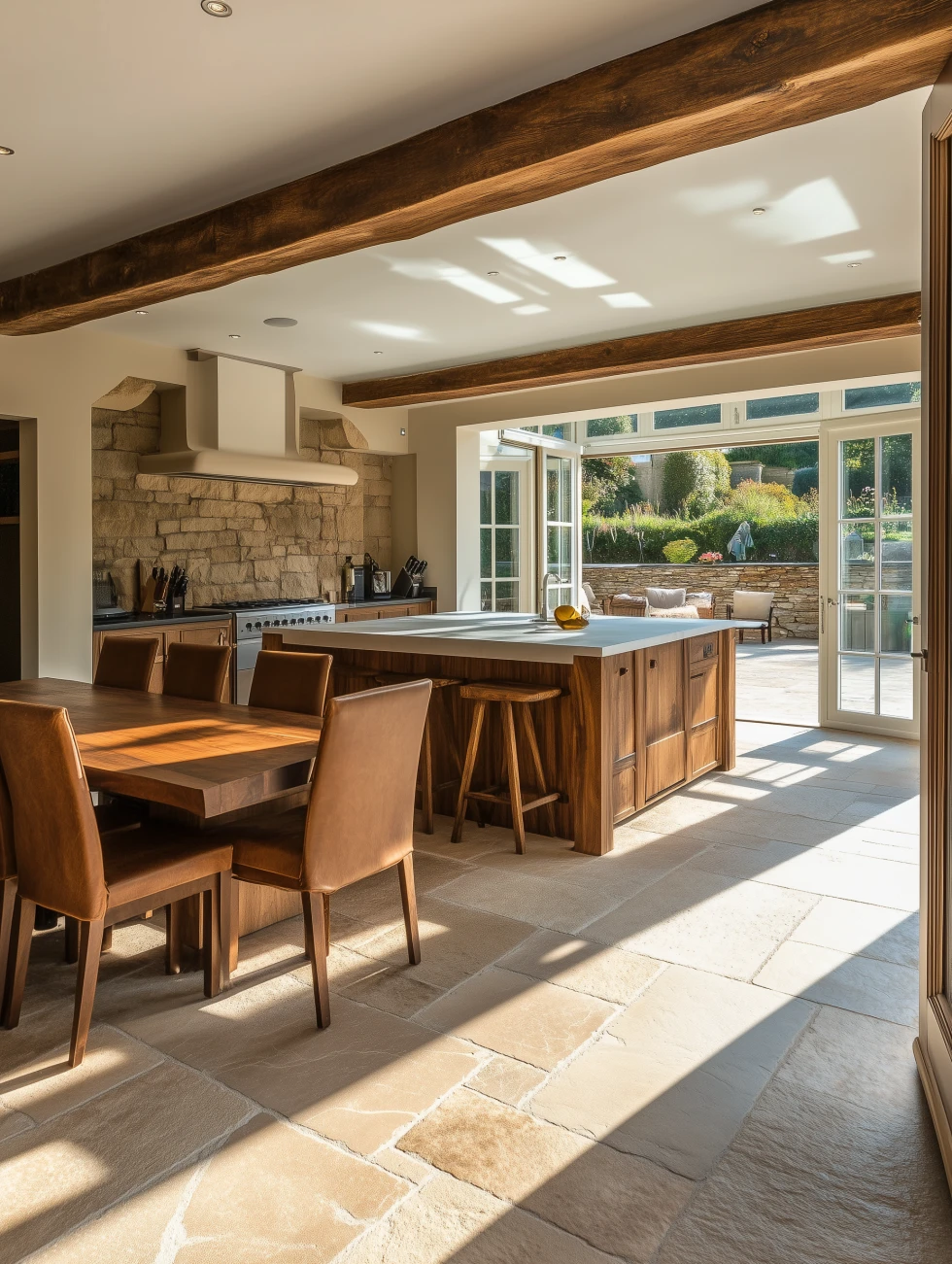
Textured stone effect tiles offer a stylish and practical option for modern kitchen floors. These tiles replicate the look and feel of natural stone whilst providing the durability and easy maintenance of porcelain or ceramic.
You can choose from a range of realistic stone textures, including slate, limestone, and travertine. The subtle surface variations add depth and interest to your kitchen floor, creating a sophisticated ambiance.
These tiles are particularly well-suited to open-plan kitchen-living areas, as they seamlessly blend indoor and outdoor spaces. They’re also an excellent choice if you’re aiming for a rustic or industrial-inspired kitchen design.
Stone effect tiles are available in various sizes and formats. Large-format tiles can make your kitchen appear more spacious, whilst smaller tiles allow for intricate patterns and layouts.
For added safety, opt for tiles with a slightly rougher texture to provide better grip underfoot. This is especially important in areas prone to spills or splashes.
Pair your textured stone effect tiles with sleek cabinetry and modern appliances for a striking contrast. Alternatively, complement them with natural wood elements for a harmonious, earthy feel in your kitchen.
Choosing the Right Tile Material
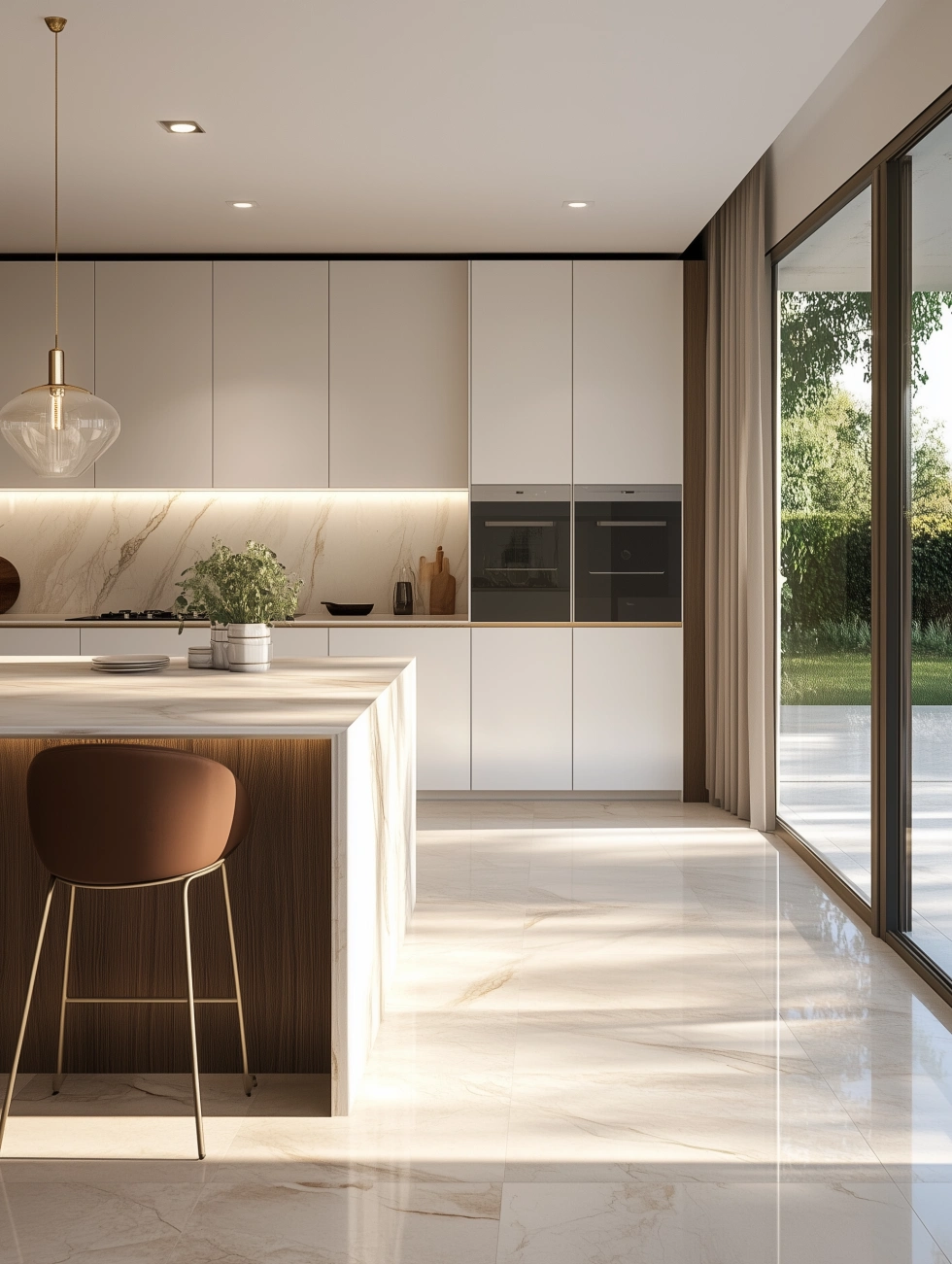
Selecting the ideal tile material for your kitchen floor involves weighing factors like durability, maintenance, and aesthetics. The right choice depends on your specific needs and preferences.
Ceramic vs. Porcelain Tiles
Ceramic tiles are a popular and affordable option for kitchen floors. They’re easy to clean and come in a wide variety of colours and patterns. However, ceramic is more porous and less durable than porcelain.
Porcelain tiles are denser and more water-resistant, making them highly suitable for high-traffic kitchen areas. They’re also more resistant to staining and chipping. While pricier than ceramic, porcelain offers excellent long-term value.
Both types can mimic natural materials like wood or stone, giving you versatile design options. Consider your budget, maintenance preferences, and aesthetic goals when choosing between ceramic and porcelain.
Natural Stone Options
Natural stone tiles add a luxurious, timeless appeal to kitchen floors. Options include:
- Marble: Elegant but requires regular sealing and careful maintenance
- Granite: Extremely durable and resistant to scratches and stains
- Slate: Offers a rustic look with good slip resistance
- Travertine: Provides a warm, earthy aesthetic but is more porous
Natural stone tiles are generally more expensive than ceramic or porcelain. They also require more maintenance, including periodic sealing to protect against stains and moisture damage.
Considerations for Durability
When selecting kitchen floor tiles, durability is crucial. Consider these factors:
- Foot traffic: High-traffic kitchens need harder, more wear-resistant tiles.
- Water resistance: Choose tiles with low porosity to prevent moisture absorption.
- Slip resistance: Look for textured surfaces or smaller tiles with more grout lines for better traction.
- Hardness rating: The Mohs scale rates tile hardness from 1 (softest) to 10 (hardest).
Porcelain and granite tend to be the most durable options. Ceramic and some natural stones may be more prone to chipping or cracking. Always check the manufacturer’s recommendations for specific use in kitchen environments.
Colour and Pattern Considerations
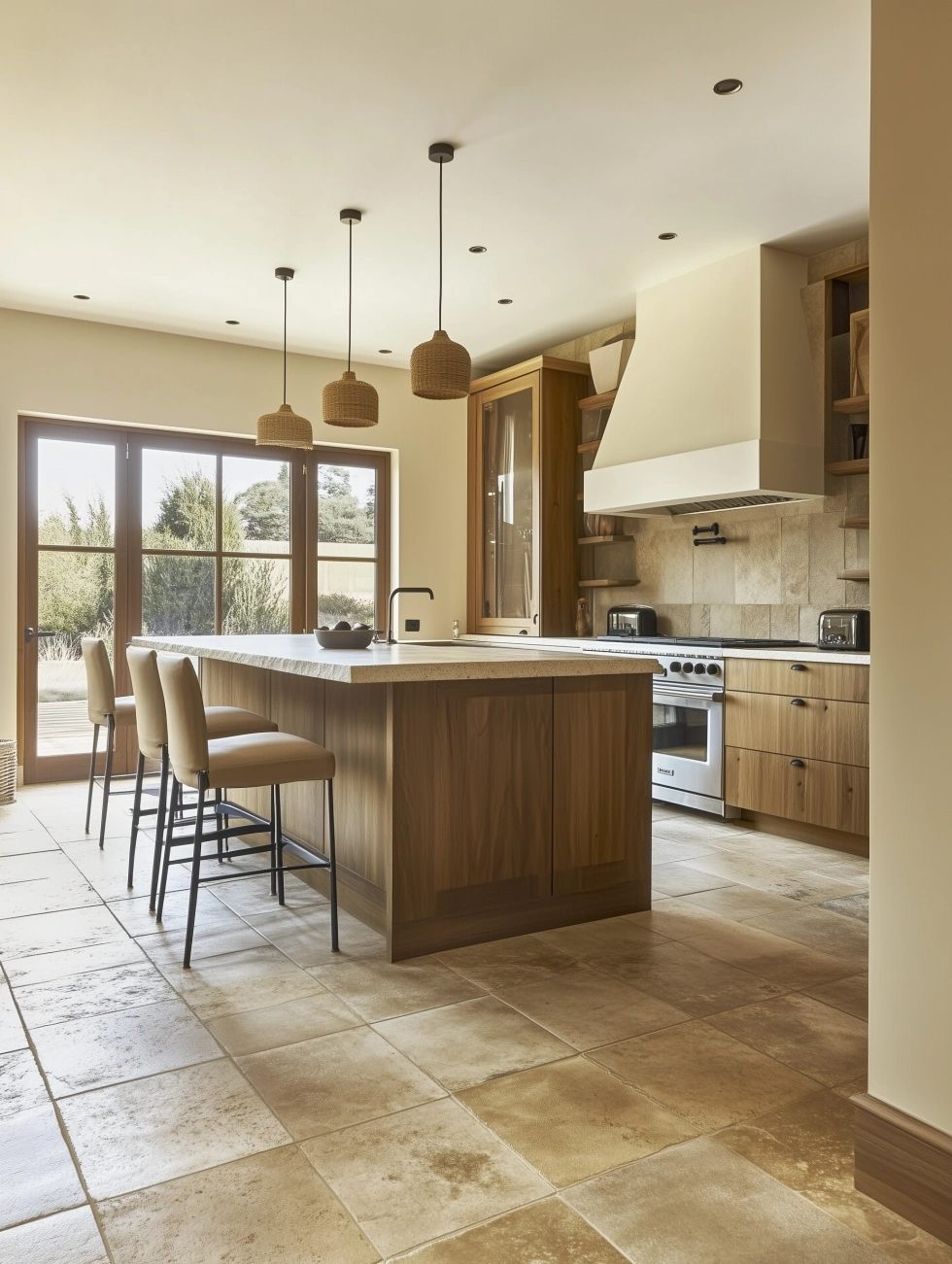
Selecting the right colours and patterns for your kitchen floor tiles can dramatically transform the space. Consider current trends and how to incorporate eye-catching designs that complement your overall aesthetic.
Trends in Modern Kitchen Colours
Neutral tones remain popular for kitchen floor tiles, offering a timeless appeal. Greys, beiges, and whites create a clean, sophisticated look that pairs well with various cabinet colours and worktop materials.
For a bolder statement, deep blues and rich greens are gaining traction. These hues add depth and character to your kitchen whilst maintaining a modern feel.
Warm terracotta and earthy tones are also making a comeback, bringing a touch of Mediterranean charm to contemporary spaces. These colours work particularly well in kitchens with plenty of natural light.
Consider your existing colour scheme when choosing floor tiles. You might opt for a complementary shade to create harmony or a contrasting hue for visual interest.
Incorporating Patterns for Style
Patterned tiles can add personality and flair to your kitchen floor. Geometric designs, such as hexagons or herringbone layouts, offer a modern twist on traditional tiling.
For a subtle pattern, consider large-format tiles with a subtle marble or terrazzo effect. These create visual interest without overwhelming the space.
Bold, graphic patterns can become a focal point in your kitchen. Think black and white checkerboard or intricate Moroccan-inspired designs. However, use these sparingly to avoid visual clutter.
When incorporating patterns, balance is key. If you choose a busy floor design, keep other elements in the kitchen simple to avoid visual overload.
Remember to consider the size of your kitchen when selecting patterns. Larger spaces can handle bolder designs, while smaller kitchens might benefit from more subtle, space-enhancing patterns.
Installation Tips
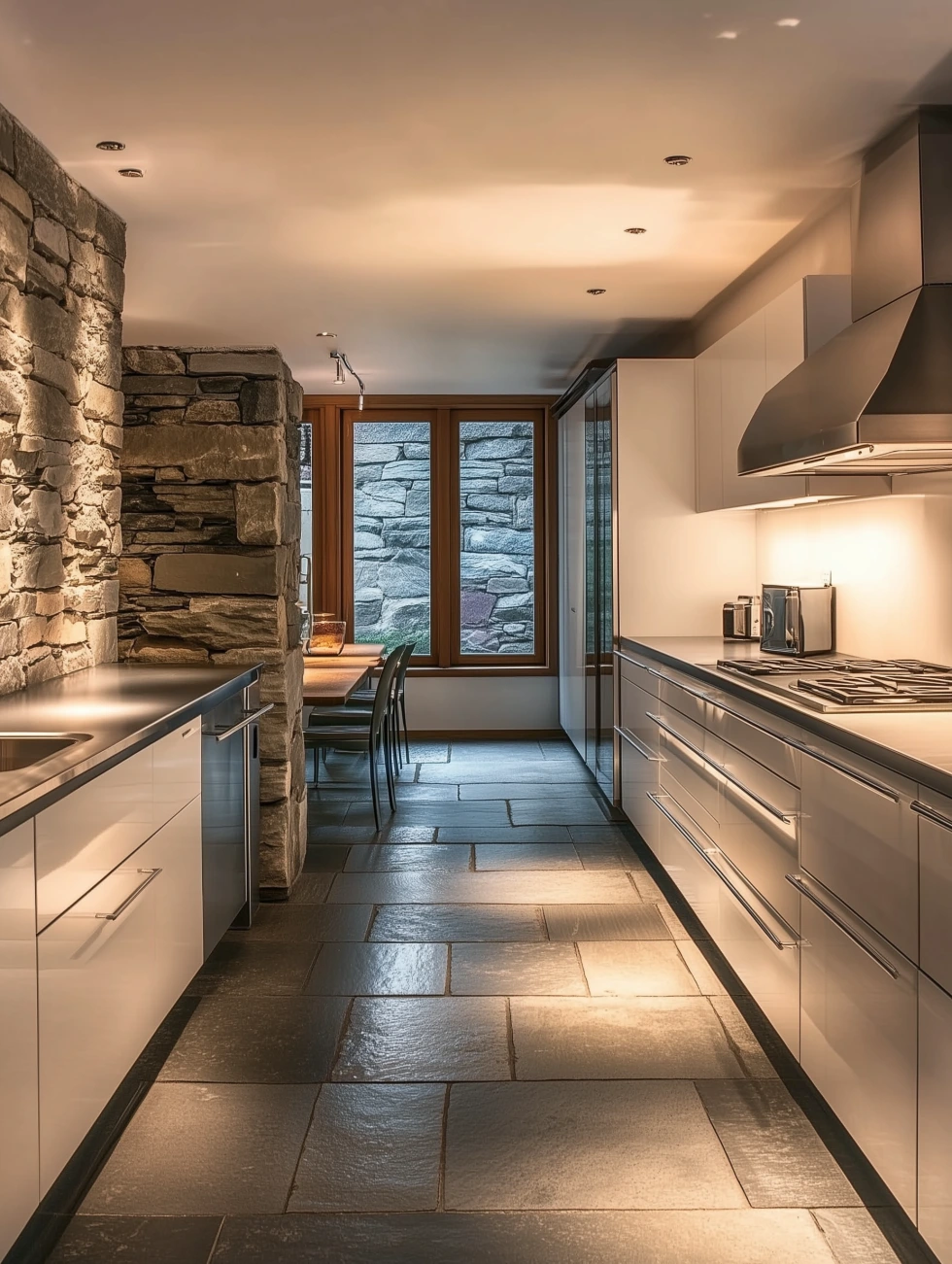
Proper installation is crucial for durable and attractive kitchen floor tiles. Careful preparation and attention to detail will ensure your new flooring lasts for years to come.
Preparing Your Kitchen Floor
Start by removing all existing flooring and ensuring the subfloor is clean, dry, and level. Repair any cracks or damage before proceeding. Use a self-levelling compound to create a smooth surface if needed.
Measure your kitchen carefully and plan the tile layout to minimise cuts and awkward pieces. Consider starting from the centre of the room and working outwards for a balanced look.
Apply a suitable primer to the subfloor to improve adhesion. For moisture-prone areas, use a waterproof membrane to protect against water damage.
Common Mistakes to Avoid
Rushing the installation process often leads to errors. Take your time and work methodically. Don’t skimp on adhesive – use the correct type and amount for your chosen tiles.
Avoid uneven spacing between tiles by using spacers consistently. Clean excess grout promptly to prevent staining. Be cautious not to walk on newly laid tiles before the adhesive has fully cured.
Neglecting to seal natural stone tiles can lead to staining and damage. Always follow manufacturer guidelines for sealing and maintenance.
Remember to account for expansion gaps around the room’s perimeter to prevent cracking as the floor settles.

